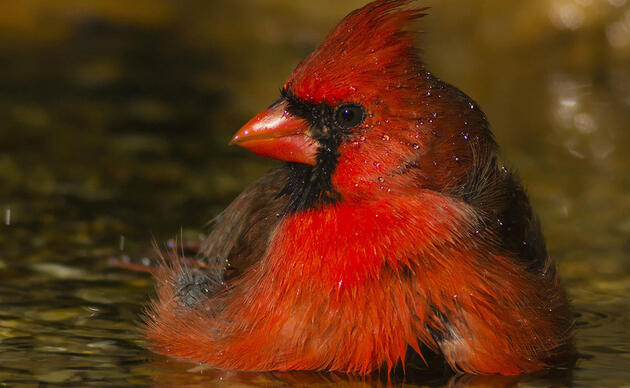Pat and Doris Leary are avid birdwatchers and citizen scientists from Fernandina Beach, FL, who volunteer their time and substantial skills to survey coastal waterbirds in Northeast Florida, coastal Georgia and Florida’s Big Bend. As they have done each winter since 2006, the Learys are conducting surveys in Florida’s Big Bend this year. Their skill at censusing wintering shorebirds—one of the most challenging groups of birds—resighting bands, and navigating this wild coastal region places them among Florida’s leading field experts on the habitat usage of shorebirds in North Florida. This is the third of several blogs in which they share their experiences and sightings, as well as the challenges these increasingly imperiled birds face.
On Nov. 16 and 17, we returned to the upper Gulf to conduct more surveys. Following a period of blustery winds, the weekend promised a narrow weather window during the month's full moon spring tides before a return to adverse winds and weather. First targeting the Horseshoe Beach area, we launched and ran south to a traditional staging area. Despite our mid-tide arrival, water levels were already high and rising over the low rake. A flock of 250 oystercatchers was present and we quickly scanned for band codes before they departed for the distant jetties.
Following the birds to the low structure, we landed on an exposed section and began methodically scanning for bands. Doris quickly spotted Oreo resting nearby and noted that she had lost her antenna and perhaps her entire transmitter. Another Massachusetts-banded bird resting a few meters distant carried bands with the new triangle code configuration. These are designed to display the entire three element code regardless how the band is exposed, thus eliminating the partial concealment problems associated with older bands with wrap-around codes. See photo above.
As we scanned the roosting birds, a juvenile female Peregrine falcon appeared flushing all the birds and creating general chaos until she failed to find an easy meal and returned to the mainland. A photo collected during the event revealed a Long-billed Curlew flushed off the rocks and previously undetected from our vantage point. Prior to departure, we motored along the rocks collecting photos of banded birds in the event we missed concealed bands from our stationary position.
Returning to Old Town, we discovered a freshly-struck Woodcock along a marshy section of 351 and, before the weekend was over, we would note the arrival of many other winter-resident birds to the region.
Sunday morning we drove to Cedar Key to survey multiple roost sites as the birds arrived and before they massed in high numbers. West of town, we found modest flocks at traditional sites along with high numbers of Dunlin. Several Piping Plovers and a single Snowy occupied one sandy site and just prior to high tide we visited a primary roost where we collected 44 band codes from 434 birds. Although a steady south wind blew all morning, it suddenly abated as we rounded a point and headed across a broad expanse of open water to access sites east of town.
Scattered flocks of Buffleheads and Scoters occupied the shallow Gulf waters and our first fall Common Loon was sighted preening on the surface.
Despite the calm conditions, we encountered just one vessel as we approached roost sites east of Cedar Key. There we found thousands of shorebirds of many species massed on a series of low rakes in open water; with much caution, we slowly approached the flocks and stepped out of our vessel in shallow water to make observations from submerged rakes at a safe distance from the occupied sites.
Our vantage provided a front row seat to a natural spectacle of interesting sights and sounds since the many species engage in a continuous chorus of low vocalizations and occasional squabbles. While scanning the oystercatchers and recording numerous band codes, we noted the frequent flushing of yet more shorebirds flocks well to our east, but could not detect an obvious threat. Sometime later, the mystery was solved when the resting birds exploded into flight with a roar of wings ahead of an onrushing Peregrine. After a brief series of shallow stoops and low passes, the adult lost interest and departed the area, permitting the mass of birds milling about in the skies to reoccupy their roost and resume their peaceful slumber.
On our return to Cedar Key, we diverted to distant Atsena Otie Key to inspect its sandy shorelines and found a huge flock of Dunlin occupying a small spit and concealed amongst them was a single Piping Plover. As we glassed the birds, a mother and child arrived to move their canoe and even before we could exchange greetings, the boy bolted toward the birds compelling us to shout: Stop! Perhaps surprised by our reaction, he halted in his tracks and we attempted to educate mother and child about why he should not disturb the birds. Passing along more of the sandy shore we saw several sand castles and more evidence of recent recreational activity driving home the lesson that very few coastal areas remain remote from human impacts.
- You can learn more about why biologist’s band birds and how to help with resighting by clicking here.
- Follow Oreo’s migration online by clicking here.
- Join the conversation! Share your Florida banded bird sightings on Facebook.
By Jonathan Webber
Stay in Touch!
Show your love of birds today. Subscribe to receive email updates about Audubon's conservation work and hear about opportunities to help birds in your area or nationwide.




